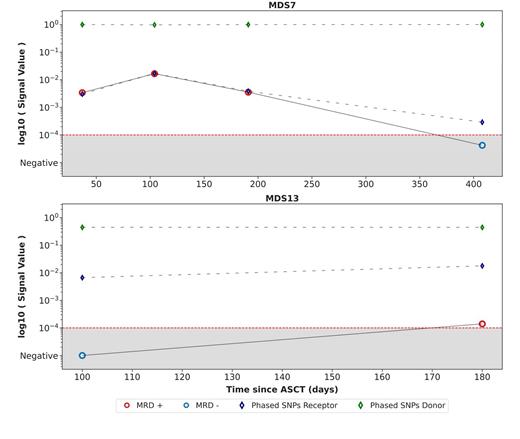Background:
Minimal Residual Disease (MRD) and chimerism monitoring in patients with Myelodysplastic Syndrome (MDS) is essential to track and quantify the proportion of donor and recipient cells to assess engraftment and treatment efficacy. Next Generation Sequencing (NGS) is rapidly evolving, can identify several somatic mutations simultaneously, quantifies allele burden, and is a suitable technology for this task. Traditionally its main limitations have been high single base error rates, which limited the sensibility to 0.1-1% Variant Allele Frequency (VAF). However, sensitivities up to 10 -4 VAF can be achieved by applying novel ultrasensitive personalized sequencing techniques.
Aims:
This study explores the applicability of PhasedSNP, a deep sequencing approach that quantifies chimerism in parallel to MRD in MDS patients after Allogenic Stem Cell Transplantation (ASCT).
Methods:
We included 24 patients older than 18 years who underwent ASCT between 2015 and 2022 at four third-level hospitals. We excluded patients with missing follow-up due to procedure-related mortality or relapse before day 100 and patients with unavailable samples. Fifty-three post-transplant samples were sequenced (six at day +30; two at +60; 21 at +100; 21 at +180, and three at day +360). Seven additional pre-transplant samples were included to confirm the donor and receptor signal switch.
The genomic DNA of the donor and receptor was sequenced with an in-house PhasedSNP panel that covers 58 regions with paired polymorphisms in less than 15bp. Receptor DNA was also sequenced with a 42-gene panel (Ion Torrent TM) to identify somatic mutations used as biomarkers in follow-up samples to quantify MRD as previously described in ( Onecha E. et al. Haematologica 2019). Briefly, an amplicon-multiplexed mini-panel was defined for every patient to detect the selected MRD biomarkers and donor/receptor phased SNPs identified at diagnosis. The mini-panel included molecular-tagged primer pairs to amplify every selected marker (PhasedSNPs and somatic mutations) in three biological replicates. Final libraries were sequenced on the Ion S5 System platform with a median coverage of 211,190 reads per amplicon. A median of 558 ng of genomic DNA (range 73.44 - 858.6 ng) was sequenced in follow-up cases.
Results:
After excluding potential CHIP and Germline mutations, the most frequently mutated genes in the cohort were STAG2 (21%), SETBP1 TP53 RUNX1 and ETV6 (16% each one). The baseline genotyping permitted to identify at least one somatic MRD biomarker in 79% of the patients (19/24), and 50% (12/24) presented more than one somatic mutation. MRD could be calculated for 42 of 53 samples. Thirteen patients presented sample at day +180 and clinical information. Four of them progressed, being three of them MRD positive. At this time-point the sensitivity of the test was 75% and the negative predictive value of 86%.
The baseline PhasedSNP panel identified chimerism biomarkers (donor and receptor) for all patients. The PhasedSNP chimerism test presented a dynamic detection range below 10 -5 in serial dilutions. The test was positive for 48/53 samples using a threshold of 10 -4, with an average signal of 7·10 -3 (range 2·10 -5 to 4·10 -2). The correlation between PhasedSNP chimerism and MRD was high (R=0.921, p<0.001). However, the chimerism signal was consistently above the MRD signal, most likely due to the detection of healthy receptor cells with the PhasedSNP test. This can be seen in the two examples presented in the figure, with one patient ( MDS7, Figure, top) with an equivalent signal of chimerism at days +30, +100, and +180, but with MRD negativity at day +420 and two logarithms reduction in chimerism compared the highest value (day 100). Regarding the other patient, MDS13 ( Figure, bottom), chimerism and MRD dynamics evolve parallel but with more than two logarithmic differences between both values. This patient was MRD negative at day +100, but positive at day +180, and relapses one year later.
Summary/Conclusion:
NGS-based parallel detection of chimerism and MRD in MDS is feasible and has high applicability and sensitivity, with several advantages compared to traditional methods. Nevertheless, further research and a larger cohort is necessary to draw meaningful conclusions.
Disclosures
Barrio:Altum Sequencing Co: Current Employment, Current equity holder in private company. Martín-Muñoz:Altum Sequencing Co: Current Employment. Dorado:Altum Sequencing Co.: Current Employment. Ballesteros:Altum Sequencing Co.: Current Employment. Ruiz-Heredia:Altum Sequencing Co.: Current Employment. Rodriguez:Altum Sequencing Co.: Current Employment. Ayala:Novartis: Consultancy, Speakers Bureau; Incyte: Consultancy; Astellas, BMS: Speakers Bureau.


